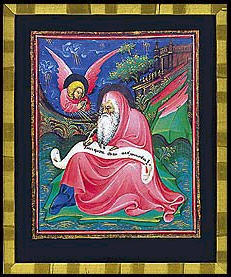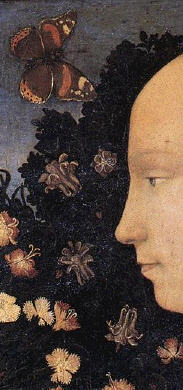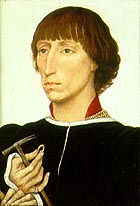In the following list we observe the family of Niccolo III. d'Este, according to our question, which persons might have influenced the situation from the first of January 1441. Some researchers express the opinion (Pizzagalli), that Niccolo had around 300 children (which seems to be exagerated, but we are not near enough in our conditions of observation). We couldn't detect so much, the general talking is about 19, which might have had some importance.
The 3 Marriages
- 1397 Gigliola di Carrara
(*ca 1382, +of the plague +1416), 0
children -
2. 1418 Parasina Malatesta
(*1404, +beheaded at Ferrara 1425); 3
children (Nr. 7, 8 and 9) -
3. 1429 Ricciarde di Saluzzo
(+16.8.1474) 2 children (Nr. 13 and 14)
Other mothers of children: -
Stella del Tolomei detta dell Assasino (1405, 1407, 1413)
-
Catarina di Taddeo (1406)
-
Filippa del Tavola (1425)
-
Anna de Roberti (1435, 1440)
and others
The 19 known Children and their state in January 1441
- 1. Ugo, [by Stella dei Tolomei detta dell'Assasino]* 1405, +beheaded at
Ferrara 1425, in 1441 dead. But present together with Parisina Malatesta, his stepmother, as a
dark shadow for all family development (Story of Ugo and Parisina).
-
2. Meliaduse [by Caterina del Medici? mor di Taddeo] Meliaduse, Abbot
of Pomposa and Ferrara, *1406, +1452. He appears as friend of
Alberti, who was an important humanist at the court of Ferrara in Leonello's time (Alberti).
-
3. Leonello [by Stella dell´Assassino] Signore ereditario di
Modena, Ferrara e Reggio (1441-50), etc.
*Ferrara 21.12.1407, +Palazzo
di Belriguarde 1.10.1450.
1m: Ferrara 1.1.1435 Margherita Gonzaga (+7.7.1439) (Gonzaga-influence),
2m: 1444 Maria (+1449) an illegitimate daughter of King Alfonso
V of Aragon.
In 1441 he was a young widower in the age of 33 and the exspected heir of Ferrara and
possible husband-in-spe to Bianca Maria Visconti.
-
4. Margherita, (birthyear is unclear), m. Galeotto II Roberto Malatesta,
Signore de Rimini; her husband had become with 12 years in age heir of Rimini (1427) after the
death of Pandolfo Malatesta, probably the marriage happened around that time.
Reports sound, as if the marriage wasn't consumated; the young Galeotto turned
into religious feelings and was as ruler not usable, in 1432 he abdicted
and became a Franciscan monk and died soon after. The church reacted to his unusual behaviour by
declaring him a "Beato"
("blessed").
With militaric force the younger half-brother Sigismondo Malatesta fought his way to establish his
rulership and earned early fame as Condottieri, which became his major occupation in the rest of his life;
he married a Parisina daughter then, after
a connection to a daughter of Carmagnola had become uninteresting cause the execution of Carmagnola
(Carmagnola was a famous condottieri, first in the service of Filippo Maria, then of Venetia;
he was assused of treason and killed).
Margherita, whose sexual reluctance might have played a key-role in the religious development of
Galeotto Roberto, became lost in history (?) - but probably she is identical with Margherita, married to
Galasso
III Pio; this identical or second Margherita, called an illegitime daughter of Niccolo,
died in 1452, living in a palace, which is now a famous sightseeing in Carpi (Carpi is near Modena;
see palazzo). Probably it is talked from her in this sentence of an
internet document:
The Casa Romei was built in 1442 for the banker husband of an Este princess, in the centre of the
addizione of Niccolo II (1386). It was bequeathed to the Order of the Poor Clares ...
The poet Boiardo (Tarocchi poem) had later difficulties with the Pio-family (Margherita was dead then).
Most genealogical tables even doesn't know her, she appears only, when researching in detail. One of her (? - or her husband) sons
was beheaded at Castelvecchio in Ferrara 17-10-1469. It is unclear, if she lived at Ferrara in 1441.
Considering "Margheritas virginity", which in consequence caused Galleotto Roberto's short
reignment (1427 - 1432) in context to Parisinas "everybody-shocking-death" shortly before (1425), we get a
feeling, what psychologically in this "teenager-marriage" might have had happened.
-
5. Borso [by Stella dell´Assassino], Signore in Ferrara in 1450 - 1471,
Duke of Modena and Reggio from 1452 on, Duke in Ferrara in 1471, successor of his brother Leonello.
*1413, + Ferrara 1471, in 1441 in the age of 26. He stayed unmarried until death
for unknown reasons (perhaps fear of death, another suggestion aims at homosexuality).
He tried in this time successless the business as condottiero and was captured after a battle with big losses against Sforza (battle of Soncino, June 1440) short before Maria Bianca's visit, it is unclear, if he was already released at the time of her visit.
-
6. Alberto, *1415, + (probably dead before birth of Alberto 2, eventually
already dead before 1421, birth of Alberto Carlo), earlier
presentations didn't realise, that there were 2 persons with the same
name; in 1441 probably dead.
-
7. Gurone, Abbot, +1484; he left an illegitimate son; in 1441 probably
already in functions of the church.
-
8./9. Ginevra [by Parisina] *24.3.1419, twin; married 1433 Sigismondo Pandolfo
Malatesta, died (possibly killed by her husband) in October 1440; the
news should have reached Ferrara in late October 1440 during Bianca
Marias visit and should have influenced the mood of all persons present.
It was the 3rd marriage in short time between the houses of Este and Malatesta and
all ended in a catastrophe: Parisina - Niccolo (1418), Margherita - Galeotto Roberto (1427 or little later),
Ginevra - Sigismondo (1433).
Some art historians, suggesting a date between (1436 - 1438), believe, that she was painted by Pisanello on the famous picture
"unknown Este princess".
The death of Ginevra in late 1440 occurred in a familiary situation, where all marriages of the generation of the Niccolo-children had ended in disaster (early death of one of the partners) - and that all after the familiary drama around Ugo and Parisina. Under these conditions Bianca Maria might have viewed on a possible marriage to Leonello with great scepticism. And she would have been right with it - Isotta's first marriage (1444) ended in the same year by murder, Leonello's marriage (1445) ended after 4 years and Beatrice had her first husband for only one year (1448). Isotta's second marriage was the first marriage which endured a longer distance of ca. 10 years.
-
8./9. Luzia [by Parisina] *24.3.1419 (twin), +28.6.1437; m.1437 Carlo
Gonzaga, Signore di Sabbioneta (+21.12.1450); in 1441 dead nearly for 3
years, she died short after the marriage and "the whole court mourned"; her husband Carlo Gonzaga,
the new widower, fighting at Filippo Maria Visconti's side, might had become
Bianca Maria's husband and was a serious candidate, when the Filippo-Francesco-alliance was in dispute. After the death of Leonello's wife,
however, in 1439, Leonello seems to have been the more promising husband-in-spe, or Carlo discarded his chances, when he became prisoner in the recent Venetian-Milanese wars (battle of Tenno/Castel Romana, November 1439).
-
10. Alberto Carlo [by Parisina] *1421, +aged 21 days, in 1441 dead.
-
11. Isotta [by Filippa della Tavola] *Ferrara 1425, + in a plague 1456;
1m: Oddantonio da Montefeltro, Cte d'Urbino (*1425 +1444); the husband is murdered short after the marriage, the regency is taken by the young Federico Montefeltro, who later becomes a successful condittiero, duke of Urbino and a famous book-collector and protector of the arts (he's involved in the development of Ludovico Lazzarelli and the Mantegna Tarocchi. Nonetheless of this later positive development the murder case is a great scandal in 1444 (murder in 1444).
2m: 1446
Stefano Frangipani, Cte di Segni (= István, Ct of Veglia and Modrus, Bán of Croatia, +1481; Bán is the title of a regent of Croatia inside the Hungarian kingdom). The only son of the marriage, Bernát, married before 1476 Luisa Marzona d'Aragona, that is a daughter of the sister of Leonello d'Este's second wife (marriage 1445). Some concrete arguments from the familiary situation of the Aragons and the general Trionfi development make it plausible, that the Bernát/Luisa marriage was involved in Trionfi customs and possibly in the development of Trionfi cards (Dokument 32, Dokument 33 and the known descriptions of other Aragon daughter marriages around this time: Eleanore d'Aragon - Ercole d'Este 1473; Beatrice d'Aragon - Matthias Corvinus, king of Hungary 1476; Camilla Marzano d'Aragona - Costanzo Sforza 1475 (Luisa's sister)).
The Frangipani were an old Roman family, an early branch of it wandered to Croatia.
It might be, that Isotta's second marriage opened (or revived) an important diplomatic Italian way to Hungary (a Ferrarese girl, an earlier Beatrice d'Este, had married in 1235 the Hungarian king Andrew II; her grandson much later became Hungarian king himself, reigning 1290 - 1301); it followed, that the young Janus Pannonius (* 1434) of North Croatia studied in Leonello's and Borso's Ferrara and became a famous poet, who even impressed Cosimo di Medici at the occasion of a visit. In 1459 he became bishop in Hungary, the related Aragon family married 1476 a daughter to the king of Hungary and cardinal Ippolito d'Este as a young man visited Hungary 1493 and asked for a Tarocchi play in a letter to his mother. By this way Hungary developed an own form of early renaissance (Virtues in Hungary).
Isotta had nearly the same age as Bianca Maria Visconti - this makes her a very interesting person for the situation of
December/January 1441.
She is in my opinion a second candidate as object of the Pisanello picture (it's also suggested in art history, that the picture
was done 1443/1444).
-
12. Beatrice, *9th of April 1427, + before 29.11.1497; she married with 21 years (that's comparatively late) 7th of October 1448 Niccolo di Correggio, who died one year later (11th of July, 1449). She had a son
of him, born after the death of the father, with the same name: Niccolo di Correggio. He was educated in Ferrara (even after the mother left to Milan) and became a great poet, theatre-organizer, warrior and courtier with an adventurous life and a complex biography, rather important for the early development of theatre (as the d'Este court became one of the most modern courts in Europe, theatre developed first forms here - this beside the great contribution of the court to the development of music and poetry and
literature generally - Boiardo, Ariost, Tasso).
In 1455 (or 1454) Beatrice married Tristano Sforza (an elder son of Francesco Sforza's earlier relations before Bianca Maria), thus generating a stable link between the Este and Sforza families. Tristano got the role of a Sforzian chief diplomat in the course of time (likely with some education at the d'Este court) and Beatrice became a second grande dame in Bianca Maria's Milan (long before the other Beatrice d'Este - a niece to the older by the brother Ercole d'Este - made her very famous appearance in Milan as wife of Lodovico Sforza near to the end of the century and near to the end of the great time of the Sforza). Her life became difficult under Galeazzo's reign (since 1466), cause the relations Ferrara-Milan cooled down. Galeazzo forbade her to have contact to her sonthen.
After Galeazzo Maria's death (1476) and the death of her husband (1477) she influenced in a critical situation the widow Bona of Savoy to pass the reignment from Simonetta to Lodovico Sforza in 1478 - this caused deciding political changes in the state of Milan with Lodovico as the first man in the state.
From her it is known, that she was in her youth "the queen of the feasts in Ferrara" and that Bianca Maria danced at her
wedding (with the involvement of famous dance-masters). It became a proverb, that "seeing Beatrice d'Este dance would be like being in paradize".
In the time of the younger Beatrice d'Este (1475 - 1497) in Milan, wife of Lodovico Sforza, the elder Beatrice d'Este still was living in Sforza Castle with splendid rooms and in honoured position. She arranged a party at the birth of the son of the younger Beatrice.
I seems evident, that Beatrice and Bianca Maria Visconti (nearly same age) were great friends and this should go back to Bianca Maria's stay in Ferrara in winter 1440/1441. She survived Bianca Maria more than 25 years.
-
13. Camilla, unclear year of birth, married 1448 Rodolpho Varano di Camarino (+1464),
in 1441 perhaps 8 - 12 years old.
The Varano family was involved in the biography of Lazzarelli and it seems, that Lazzarelli might have met Borso d'Este 1471 at the court of Camerino on Borso's famous journey to Rome (Mantegna Tarocchi). The description of a daughter of the house praises the court as full of joy and games - cards are explicitely mentioned. The relations between Este and Varano court were still vivid in later times.
-
14. Ercole I, Duke of Modena and Ferrara (1471-1505), *1431, +1505;
m.Ferrara 1473 Eleonore of Naples (*1450 +1493)
In 1441 Ercole is in the age of 9 - and he
gets in July 1442 a Trionfi deck. After the marriage of Leonello with a daughter of Alfonso of Aragon Ercole with his younger brother Sigismondo was send for education to the court of Naples and returned late ca. 1460. He became duke of Ferrara and Modena and Reggio after the death of his brother Borso in 1471, which gave reason for a conflict with Leonello's son of the marriage to the Gonzaga daughter, Niccolo. Niccolo tried a riot by surprize in 1476 and was consequently beheaded together with many of his cooperators.
-
15. Sigismondo, Signore di San Martino, *1433, +Ferrara 1507;
married Pizzocara N. in 1441 in the age of 7 - gets in July 1442 together with Ercole a Trionfi
deck, has later as adult occasionally greater losses by gambling.
-
16. Albert (2) + 1508, unclear age in 1441; the 3rd Albert in the family.
In 1476, in the reignment of Ercole, he is the 3rd best paid person at the court,
so he is not unimportant (Sigismondo - legitime son - got about 2000 Lira Marchesana,
Albert - illegitime son - got 800, but 800 was a huge sum, 10 times as much as a
very high official could expect and 400 - 800 times much more than a humble
servant got in a month).
-
17. Rinaldo, [by Anna de Roberti] abbot of S.Maria della Pomposa,
Signore di Ostellato, * Ferrara ca. 1435, +Ferrara 1503; m.1495 Lucrezia
of Montferrato (*1468 +1508), in 1441 probably 5 years old.
-
18. Bianca Maria, [by Anna de Roberti] *1440, + Mirandola 1506 m.1468
Galeotto I Pico della Mirandola (+1499) born during Bianca Marias visit; she is important,
cause Bianca Maria became godmother. She got a careful education - likely protected by the far godmother Bianca Maria and got a splendid marriage at the Pico court.
-
19. Orsina, m. 1. Aldobrandino Rangoni, 2. ... Malatesta, 3. Andrea
Gualetti, unclear age.
I heard further of a son Fulco connected to the year 1433, of a daughter Viridis, which became a nun (Fulco and Viridis are names used in the older Este family) and of a second or third Margherita (married to a Francesschino in Verona). |


Pisanello:
Unknown Este prrincess |


